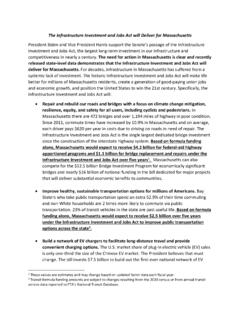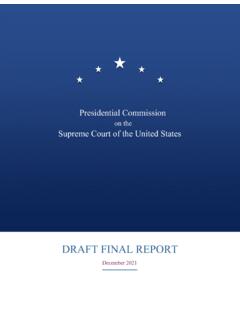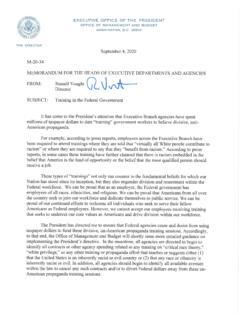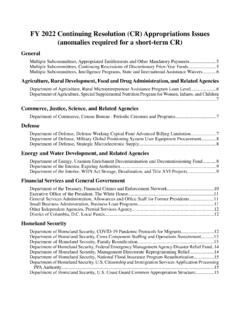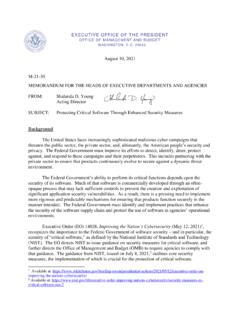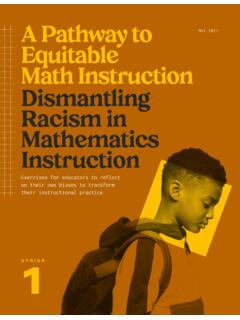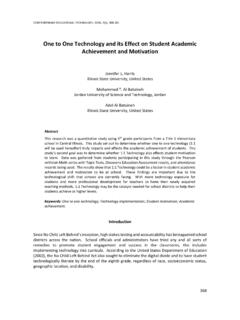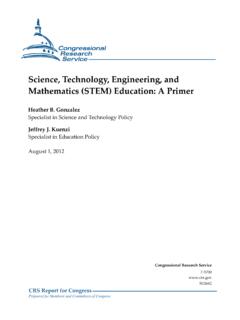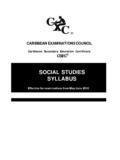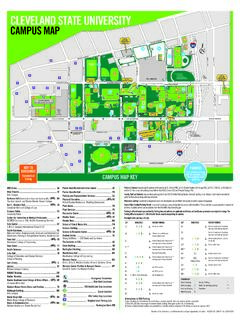Transcription of BEST PRACTICES FOR DIVERSITY AND INCLUSION IN STEM ...
1 BEST PRACTICES FOR DIVERSITY AND INCLUSION IN stem education AND RESEARCH: A GUIDE BY AND FOR FEDERAL AGENCIES A Report by the INTERAGENCY WORKING GROUP ON INCLUSION IN stem FEDERAL COORDINATION IN stem education SUBCOMMITTEE COMMITTEE ON stem education of the NATIONAL SCIENCE AND TECHNOLOGY COUNCIL September 2021 BEST PRACTICES FOR DIVERSITY AND INCLUSION IN stem education AND RESEARCH: A GUIDE BY AND FOR FEDERAL AGENCIES i About the National Science and Technology Council The National Science and Technology Council (NSTC) is the principal means by which the Executive Branch coordinates science and technology policy across the diverse entities that make up the Federal research and development enterprise.
2 A primary objective of the NSTC is to ensure science and technology policy decisions and programs are consistent with the President's stated goals. The NSTC prepares research and development strategies that are coordinated across Federal agencies aimed at accomplishing multiple national goals. The work of the NSTC is organized under committees that oversee subcommittees and working groups focused on different aspects of science and technology. More information is available at About the Office of Science and Technology Policy The Office of Science and Technology Policy (OSTP) was established by the National Science and Technology Policy, Organization, and Priorities Act of 1976 to provide the President and others within the Executive Office of the President with advice on the scientific, engineering, and technological aspects of the economy, national security, homeland security, health, foreign relations, the environment, and the technological recovery and use of resources, among other topics.
3 OSTP leads interagency science and technology policy coordination efforts, assists the Office of Management and Budget with an annual review and analysis of Federal research and development in budgets, and serves as a source of scientific and technological analysis and judgment for the President with respect to major policies, plans, and programs of the Federal Government. More information is available at About the Federal Coordination in stem education Subcommittee The Federal Coordination in stem education (FC- stem ) is a subcommittee of the NSTC Committee on stem education (CoSTEM), which was established pursuant to the requirements of Section 101 of the America COMPETES Reauthorization Act of 2010 (42 6621).
4 In accordance with the Act, CoSTEM reviews science, technology, engineering, and mathematics ( stem ) education programs, investments, and activities, and the respective assessments of each, in Federal agencies to ensure that they are effective; coordinates, with the Office of Management and Budget, stem education programs, investments, and activities throughout the Federal agencies; and develops and implements through the participating agencies a Federal stem education strategic plan, to be updated every five years. FC- stem advises and assists CoSTEM and serves as a forum to facilitate the formulation and implementation of the strategic plan. About the Interagency Working Group on INCLUSION in stem Six Interagency Working Groups (IWGs) support FC- stem as it implements the Strategic Plan and brings together members who represent the Federal government s foremost experts in stem education .
5 Four of the IWGs are concentrating their efforts on one of each of the four pathways outlined in the Strategic Plan. These pathways include Strategic Partnerships, Convergence, Computational Literacy, (educational pathways) and Transparency & Accountability. The National Science and Technology Council (NSTC) chartered a fifth IWG, the Interagency Working Group on INCLUSION in stem (IWGIS), in response to Section 308 of the 2017 American Innovation and Competitiveness Act and focuses on broadening participation in stem as described in more detail below. A sixth IWG was formed in response to the 2020 Supporting Veterans in stem Careers Act to improve veteran and military spouse equity and representation in stem fields and careers.
6 BEST PRACTICES FOR DIVERSITY AND INCLUSION IN stem education AND RESEARCH: A GUIDE BY AND FOR FEDERAL AGENCIES ii About this Document The purpose of the Interagency Working Group on INCLUSION in stem (IWGIS) is to advise FC- stem on coordinating activities regarding INCLUSION in stem fields across the Federal government, with a focus on identifying research, best PRACTICES , and policies on how to promote DIVERSITY and INCLUSION of all groups in the Federal stem workforce, including women, people from underrepresented racial and ethnic groups, and persons with disabilities. In October 2019, members of the IWGIS set out to accomplish the group s first strategic objective: to share among Federal agencies best PRACTICES for DIVERSITY and INCLUSION , both within agencies and in the programs they support.
7 As part of achieving this objective, the group was tasked with developing a compendium on Best PRACTICES for DIVERSITY and INCLUSION in stem education and Research for Federal Agencies. The group broke down the task into three parts. First, the group developed clear definitions of evidence-based, emerging, and promising PRACTICES . Second, the group conducted a literature search on evidence-based PRACTICES for DIVERSITY and INCLUSION in stem . Third, the group incorporated data from a Best PRACTICES Solicitation (information request) from FC- stem Interagency Working Groups to FC- stem agencies, collected in August 2020. The goal was not only to identify best PRACTICES and exemplary programs but also to establish the evidence base for the existing effective PRACTICES , including findings from robust evaluations.
8 This report is the result of the extensive work conducted by the IWGIS. The compendium also includes recommendations for increasing DIVERSITY in Federal programs. Copyright Information This document is a work of the United States Government and is in the public domain (see 17 105). Subject to the stipulations below, it may be distributed and copied with acknowledgment to OSTP. Copyrights to graphics included in this document are reserved by the original copyright holders or their assignees and are used here under the Government s license and by permission. Requests to use any images must be made to the provider identified in the image credits or to OSTP if no provider is identified.
9 Published in the United States of America, 2021. BEST PRACTICES FOR DIVERSITY AND INCLUSION IN stem education AND RESEARCH: A GUIDE BY AND FOR FEDERAL AGENCIES iii NATIONAL SCIENCE AND TECHNOLOGY COUNCIL Chair Eric Lander, Director, OSTP Executive Director Kei Koizumi, Acting Executive Director COMMITTEE ON stem EDUCATIONCo-Chairs Alondra Nelson, Deputy Director, OSTP Sethuraman Panchanathan, Director, NSF SUBCOMMITTEE ON FEDERAL COORDINATION IN stem education Co-Chairs Nafeesa Owens, Assistant Director for stem education , OSTP Mike Kincaid, Associate Administrator for stem Engagement, NASA Sylvia Butterfield, Acting Assistant Director for education and Human Resources, NSF Executive Secretary Susan Poland, NASA Members Melissa Anley-Mills, EPA Charmain Bogue, VA Julie Carruthers.
10 DOE Catherine Derbes, OMB Robert Hampshire, DOT Kourtney Hollingsworth, USDA Diane M. Janosek, NSA Louisa Koch, DOC/NOAA Kay Lund, HHS/NIH Cheryl Martin, DOL Carol O Donnell, SI Albert Palacios, ED Jagadeesh Pamulapati, DoD Jeanita Pritchett, DOC/NIST Craig Robinson, DOI/USGS Gregory Simmons, DHS Jorge Valdes, DOC/USPTO Leslie Wheelock, HHS/FDA INTERAGENCY WORKING GROUP ON INCLUSION IN stem Co-Chairs Executive Secretary Nafeesa Owens, OSTP Eleanour Snow, DOI/USGS Charlene Le Fauve, HHS/NIH Javier Inclan, NSF Laura Larkin, DOD BEST PRACTICES FOR DIVERSITY AND INCLUSION IN stem education AND RESEARCH: A GUIDE BY AND FOR FEDERAL AGENCIES 4 Members Jorge Valdes, USPTO Cordelia Zecher, USPTO Evelyn Kent, DOD Louie Lopez, DOD Diann McCants, DOD Dane Samilo, DOD Daphne Chery, DOD Laura Larkin, DOD Julie Carruthers, DOE Leslie Wheelock, FDA Greg Simmons, DHS Natasha White, NOAA Dawn Tucker-Thomas, DOT Brian Lekander, ED Grace Hu, OMB Charlene Le Fauve, HHS/NIH Bryant Maldonado, HHS/NIH Elaine Ho, OSTP Daesha Roberts, NASA Pamela Hudson-Veenbaas, SI Amy D'Amico, SI Staci Rijal, DOS Noller Herbert, USDA Peggy Biga, USDA Piyachat Terrell, EPA Susan Poland, NASA Cindy Hasselbring, NSF Marlene Kaplan, DOC/NOAA Tori Smith, NSF Sheree Watson, USGS Maria Carranza.
